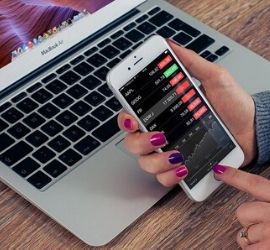Market Risk Premium – Understanding & Calculating Market Premiums
What Is Market Risk Premium?
 The market risk premium is the difference between the expected return on a market portfolio as compared to a risk-free rate of return. This premium is the additional return an investor should receive, or expect to receive for holding a market portfolio with higher risk compared to risk-free assets.
The market risk premium is the difference between the expected return on a market portfolio as compared to a risk-free rate of return. This premium is the additional return an investor should receive, or expect to receive for holding a market portfolio with higher risk compared to risk-free assets.
The market premium is part of the Capital Asset Pricing Model (CAPM). Many analysts and investors use CAPM to calculate the acceptable rate of return for an investment. At its core is the concept of risk, as measured by volatility, and reward, as measured by the rate of returns. Investors invariably prefer to have the highest possible rate of return combined with the lowest possible volatility and risk.
- The risk premium is the difference between the expected return on a riskier market portfolio as compared to the risk-free rate.
- Quantitative measure – of the extra return expected by market participants for exposure to increased risk.
- Required market risk premium – the minimum amount investors should accept. If an investment’s rate of return is lower than that of the required rate of return, then the investor will not invest. It is also called the hurdle rate of return.
- Historical market risk premium – a measurement of the return’s past investment performance taken from an investment instrument that is used to determine the premium. The historical premium will produce the same result for all investors, as the value’s calculation is based on past performance. With a historical market risk premium, the return will differ depending on what instrument the analyst uses. Most analysts use the S&P 500 as a benchmark for calculating past market performance.
- Expected market risk premium – based on the investor’s return expectation.
- The required and expected market risk premiums differ from one investor to another. During the calculation, the investor needs to take the cost that it takes to acquire the investment into consideration.
- U.S. Treasuries – Usually, a government long-term bond yield is used to identify the risk-free rate of return, as it has little to no risk.
Understanding Market Risk Premiums
Risk premium describes the relationship between returns from an equity market portfolio and treasury bond yields. The risk premium reflects the required returns, historical returns, and expected returns. The historical market risk premium will be the same for all investors since the value is based on what actually happened. The required and expected market premiums, however, will differ from investor to investor based on risk tolerance and investing styles. (Source: investopedia.com)
Investors require compensation for risk and opportunity cost. The risk-free rate is a theoretical interest rate that would be paid by an investment with zero risks. The long-term yields on U.S. Treasuries have traditionally been used as a representative substitute for the risk-free rate because of the low default risk. As a result, Treasuries have historically had relatively low yields in exchange for their perceived safety. Equity market returns are based on the expected returns from a broad benchmark index. The Standard & Poor’s 500 index or the Dow Jones industrial average are often used.
Market Risk Premium Formula & Calculation
The formula is as follows: Market Risk Premium = Expected Rate of Return – Risk-Free Rate
Example: The S&P 500 generated a return of 7% the previous year. The current interest rate of the Treasury bill is 1.4%. The premium is 7% – 1.4% = 5.6%. Therefore, the extra return to compensate for the increased risk from holding riskier securities as opposed to risk-free Treasuries is 5.6%
Application of Risk Premiums
The risk premium can be calculated by subtracting the risk-free rate from the expected equity market return. This provides a quantitative measure of the extra return demanded by market investors for the increased risk.
Once calculated, the equity risk premium can be used in important calculations such as CAPM. Between 1926 and 2014, the S&P 500 exhibited a 10.5% compounding annual rate of return, while the 30-day Treasury bill compounded at 5.1%. This indicates a market risk premium of 5.4%, based on these parameters. The required rate of return for an individual asset can be calculated by multiplying the asset’s beta coefficient by the market coefficient, then adding back the risk-free rate. This is often used as the discount rate in discounted cash flow, a popular valuation model. (Source: investopedia.com)
Capital Asset Pricing Model (CAPM)
Using CAPM, the return of an asset is the risk-free rate, plus the premium, multiplied by the beta of the asset. The beta is the measure of how risky an asset is compared to the overall market. The premium is adjusted for the risk of the asset. For example, An asset with zero risks and, therefore, zero beta, for example, would have the market risk premium canceled out. On the other hand, a highly risky asset, with a beta of 0.8, would take on almost the full premium. At 1.5 beta, the asset is 150% more volatile than the market.
Volatility
It’s important to reiterate that the relationship between risk and reward is the main premise behind market risk premiums. If an asset returns 10% every time period without fail, it has zero volatility of returns. If a different asset returns 20% in period one, 30% in period two, and 15% in period three, it has higher volatility of return. As a result, the second asset is considered “riskier”, even though it has a higher average return profile.
Limitations of Market Risk Premium Calculations
This concept is an expectancy model. As a result, it can’t be accurate most of the time.
- Too many variables – This is not an accurate model and the computation depends on the investors. That means too many variables and too little basis of proper computation.
- Past performance cannot predict future – When market risk premium calculation is done by taking into account the historical figures, it’s assumed that the future would be similar to the past. But in most cases, that may not be true.
- Inflation is ignored – It doesn’t take into account the inflation rate. Thus, the real risk premium is a much better concept that a market premium.
Final Words
It is important for an analyst or an intended investor to understand the concept of market risk premium. This is because it tries to address the relationship between risk and reward. It illustrates how the returns of an equity market portfolio differ from that of the lower risk treasury bond yields. The difference is a result of the additional risk that is borne by the investor for holding riskier securities. Basically, the risk premium compares expected returns and historical returns. However, the expected market premium usually differs from one investor to another based on their risk appetite and investment styles.
The equity risk premium ranges between 3.5% and 5.5% over the long term, while this has been slightly higher in the wake of the 2007-2008 global economic crisis, partly due to interventions by major central banks and artificially depressed interest rates. This upward shift in the equity risk premium affects investment decisions since the equity risk premium is used to estimate the cost of capital, among other applications. But the equity risk premium has experienced other periods of material shifts, with one early notable period being the post-World War era where the risk premium rose thanks to greater confidence and appetite for risk. A more recent period of note was the higher-than-usual equity risk premium experienced after the tech bubble of the late 1990s. The equity risk premium varies based on how return differences are calculated and on the risk-free rate applied, among other factors. (Source: quantilia.com)



